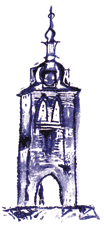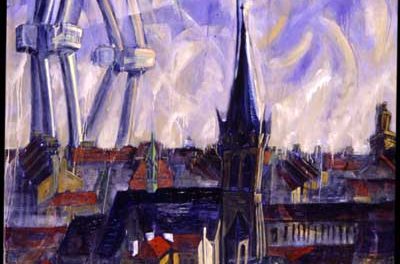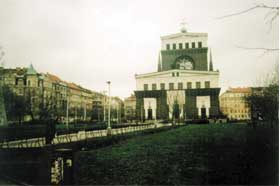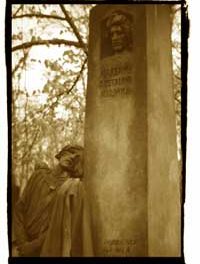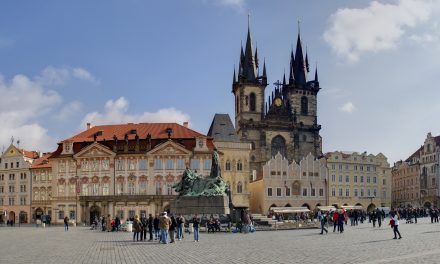While wandering through the arcades and passages of Old Town, should you not know them very well, you may very often be surprised as to where you should turn up. And should you hear a clock strike, it won’t be once, but three or four times, and quite often it’s impossible to recognize how many tower clocks are striking the hour as some of the chimes merge into chords.
But all these narrow streets, such as Karlova, Husova, Jilska, Michalska and others have, despite their antiquity, quite a bit of traffic, drawing you on your way.
Over in the Old Jewish Cemetery is an atmosphere of a different tone – here peace and quite reign supreme. The stone tombstones with their Hebrew inscriptions are overgrown with flourishing shrubbery and many of them are bowed down under the weight of several centuries.
The tomb of Rabbi Löw and those of his thirty favorite pupils, the tomb of the philanthropist Mordecai Majzl, the sarcophagus of Jacob Bassevi – a total of 20,000 graves, in some cases in several layers, one right on top of the other. Some of the tombs carry the symbols of the family – a pitcher, two hands, or names and professions – a lion, a deer, scissors and so on.
In the old Prague corner, Na Frantisku, there has been since the year 1234 a convent, of which the first abbess was Agnes, (later beatified), the youngest daughter of the Premysl line of kings, Otakar I. It was one of the largest of the Prague convents. In the maze of courtyards and streets, it’s remains have been preserved, rare relics of the early gothic age in this country.
The lazy Vltava is spanned by the famous Charles Bridge, which has on each side a row of Baroque statues, each telling a mysterious tale. We enter the Small Town and Hradcany, to Prague quarters which lie somewhat to another side of time, and as far as the city’s notorious traffic is concerned, their romantic spell has not been broken by the rush of daily life.
By going down stone steps from Charles Bridge, we reach the island of Kampa, where every April 30th the pagan party people of Prague celebrate the death of Winter by drinking themselves silly through the night, then venturing up Petrin hill to burn in effigy the Winter Witch. Kampa is a serene park where acacias blossom and which is bordered by two rows of old homes. One bank of the island is washed by the Vltava, and the other by the Certovka.
A day spent on the island flows by quietly and in harmony with the voice of the Vltava. It is most pleasant to picnic with your lover on the bank of the river and watch the river traffic float by against the backdrop of the city.
The Certovka is actually an arm of the Vltava, but it seems more to be an enchanted stream which came to Prague by mistake. Both banks of the stream are built up with old houses with balconies. These houses have little steps which in some cases go right down to the stream, and in others to wooden docks for boats.
The old mill wheel, now purely decorative, exudes charm, as does the Virginia creeper which has crawled the stone walls for centuries now. As you cross the footbridges, check the walls for watermarks, and know well the temper of the Vltava.
The Maltezske Namesti, with its church dedicated to the Virgin Mary in Chains, and the Velkoprevorske Namesti paved with upright cobblestones; the so-called “Cat’s Heads,” which are so still that it seems they have no link with the dotcom world, but belong solely to the quietude of warm twilight. Behind the beauty and magnificence of the Prague Castle and the Cathedral of St. Vitus (best enjoyed late at night), is a small street over the Stag’s Moat, which leads to a hidden splendor; Golden Street, a street of tiny houses which had at one time been destined for use by the castle guard, and where, according to legend, there lived the alchemists during the reign of Rudolf II. Until modern times people actually lived in these homes, as hard as that may be to believe.
Today, sometimes for a small fee, these houses-turned-shops can be visited, souvenirs purchased, and a fine view can be had out the back windows of the Stag’s Moat.
Even the homes of the Hradcany Quarter, the so-called “New World,” gives the impression of not being part of a large city. The beauty of the Small Town gardens with their wealth of building decorations have been shed of their seclusion and opened to all those who love Prague.
An excellent place to end your walk is at the Golden Well, a small restaurant on the terrace of a house under the castle’s walls. It too, is typical of the romance of Prague, in the same measure as the spectacular view from the Úvoz to Malostranska, the new Castle Steps, Neruda’s home “At the Two Suns”, Janska, Thunovska and Luzicka Streets, the fortification of Vysehrad, bent curved roof tiles, the blossoming chestnuts in the spring, reminders of the winter snow which blanketed the city in innocence, now giving way to the greenery, the birds, and the perfect little corners for kissing the one you love.
Enjoy.

